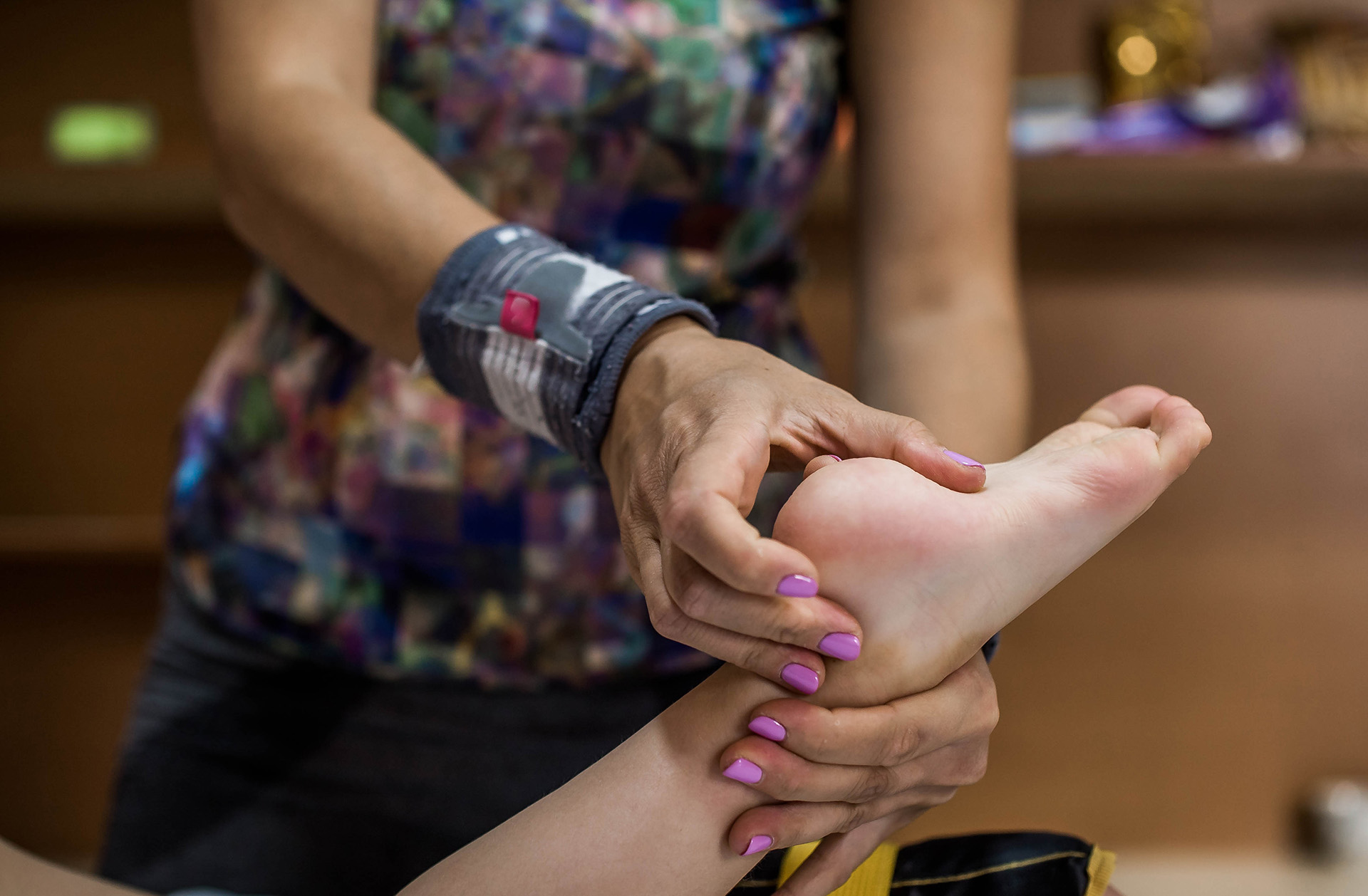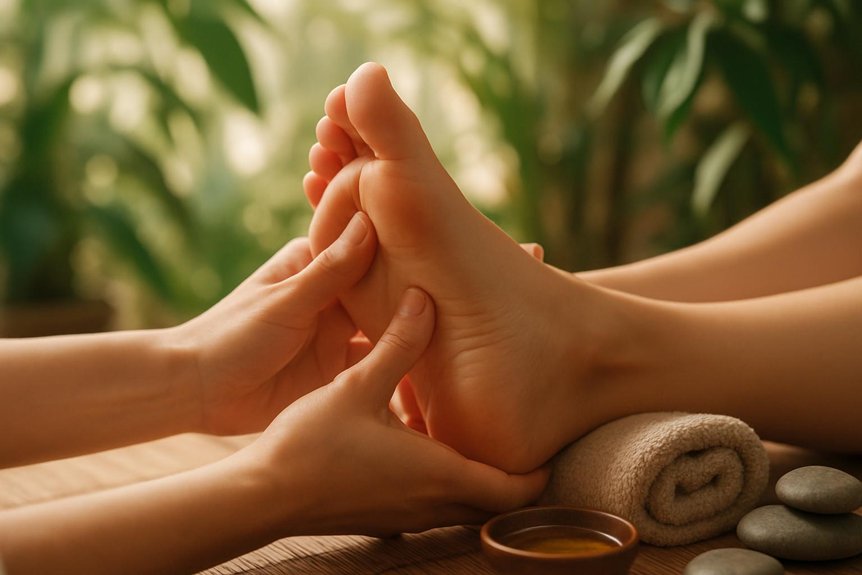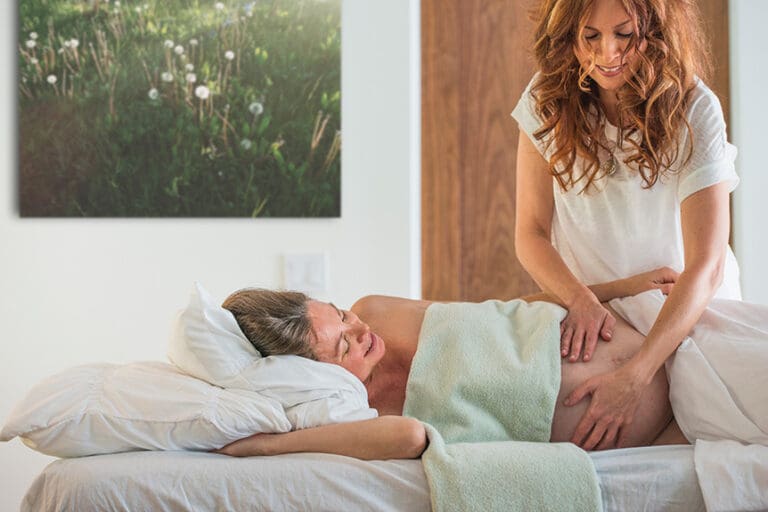It may ease constipation by activating cutaneous mechanoreceptors (A‑beta/C‑fibers), modulating spinal gating and brainstem pathways, and shifting autonomic balance toward parasympathetic (vagal) tone. Targeted pressure along foot and hand colon reflex zones, the ileocecal area, and the solar plexus point can reduce sympathetic arousal and visceral hypertonicity, supporting peristalsis. Sessions typically use graded thumb-walking and sustained pressure with attention to tolerability. It is adjunctive to medical care and red flags require evaluation. Practical techniques and precautions follow.
How It May Influence Digestive Function

Reflexology may influence digestive function through neurophysiological and autonomic pathways. Light-to-moderate pressure at specific cutaneous sites can activate A-beta and C-fibre afferents, modulating dorsal horn gating and ascending pathways to the brainstem.
This sensory input may shift autonomic balance toward parasympathetic tone, enhancing vagal efference to the gut. Resulting effects can include increased gastric motility, improved ileocecal transit, and more coordinated colonic peristalsis.
Mechanistically, it may attenuate sympathetic arousal via baroreflex and nucleus tractus solitarius integration, reducing visceral hypertonicity and fostering bowel regularity.
At Spa & Massage, therapists apply calibrated, rhythmic pressure with controlled cadence to optimise afferent signaling while maintaining comfort. Gentle diaphragmatic breathing is encouraged to amplify vagovagal reflex activity.
The approach remains supportive, adjunctive, and tailored, respecting individual sensitivity and clinical context. Many clients seek out this therapy to discover the healing power it may offer, exploring its potential benefits for digestive issues like constipation.
Key Foot and Hand Reflex Points Linked to Bowel Health
Several foot and hand reflex zones are commonly associated with bowel regulation, mapped to anatomical correlates along plantar, medial, and palmar surfaces.
On the feet, practitioners target the descending and sigmoid colon line along the lateral plantar arch of the left foot, the transverse colon reflex across the midfoot, and the ileocecal and ascending colon points on the right lateral plantar aspect.
The solar plexus point at the foot’s center is used to modulate autonomic tone.
On the hands, the colon reflex arcs traverse the palmar areas beneath the metacarpal heads, with the ileocecal region near the right thenar border.
At Spa & Massage, therapists apply graded thumb-walking and sustained pressure to these loci, aiming to influence enteric reflexes, parasympathetic balance, and segmental myofascial tension.
What to Expect in a Massage Session for Constipation
A typical massage session for constipation at Spa & Massage begins with a brief medical and lifestyle screening to identify bowel patterns, triggers, red flags, and contraindications. The therapist then explains the treatment plan, focusing on reflex maps for the colon, ileocecal valve, vagal tone, diaphragm, and pelvic floor correlates.
After warming the feet, firm, sequenced thumb-walks and hook-in-and-hold techniques are applied along the ascending, transverse, and descending colon reflexes to encourage peristaltic coordination. Specific pressure is modulated to client tolerance, seeking tender nodules or granulations that may indicate congestion.
Sessions last 45–60 minutes. Clients should expect localized soreness, warmth, parasympathetic settling (slower breathing, softened abdomen), and sometimes increased bowel sounds.
Therapists at Spa & Massage document responses and recommend session cadence based on clinical presentation.
At-Home Techniques and Self-Care Between Sessions
Beyond the in-clinic protocol, outcomes improve when clients apply targeted self-care between appointments. Spa & Massage advises brief, daily foot routines that stimulate colonic reflex areas: slow thumb-walks along the medial arch (heel to ball) to encourage peristaltic signaling, followed by circular pressure on the solar plexus point (center of the diaphragm line) to modulate autonomic tone. Gentle clockwise abdominal massage supports ileocecal-to-sigmoid transit; our therapists recommend light oil and five minutes post-meal.
Hydration (warm water) and soluble fibre aid stool viscosity, while a regular gastrocolic reflex routine—sitting on the toilet 15–20 minutes after breakfast—leverages natural motility. Diaphragmatic breathing, eight-count exhale, downregulates sympathetic drive. Short walks after meals enhance colonic motility.
Consistency, not intensity, predicts benefit.
When to Seek Medical Advice and How It Fits Your Care Plan
While zone therapy can modulate autonomic tone and support bowel motility, it is an adjunct to—not a substitute for—medical evaluation when red flags are present. Immediate medical advice is warranted for rectal bleeding, unintended weight loss, iron‑deficiency anemia, persistent vomiting, severe or worsening abdominal pain, fever, new constipation after age 50, or failure to pass gas with distension.
Patients with neurological disease, opioid use, pregnancy complications, or a history of bowel surgery should also seek guidance.
Within a care plan, it may down‑shift sympathetic drive, enhance vagal activity, and reduce pelvic floor guarding—mechanisms that can complement fibre, hydration, osmotic laxatives, and bowel retraining.
At Spa & Massage in London, therapists coordinate session frequency with GP recommendations, document responses, and adjust techniques to align with investigations, medications, and dietetic advice.
Conclusion
In essence, it may support constipation management by modulating autonomic tone, reducing perceived stress, and promoting enteric motility via reflex point stimulation. Evidence remains mixed but suggestive: a small randomized study reported approximately 30–40% improvement in bowel movement frequency versus control over 4–6 weeks. Sessions at Spa & Massage emphasise tailored pressure, breathing, hydration, and gentle movement, aligning with a multi-modal plan. It should complement—not replace—dietary fibre, fluids, activity, and medical evaluation for red flags or persistent symptoms.



